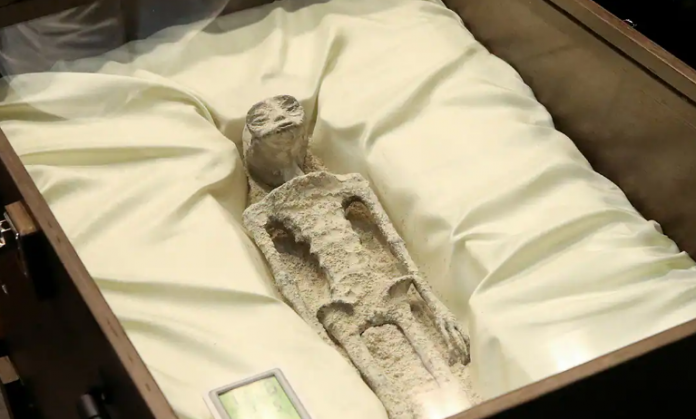NASA concluded its highly anticipated media briefing, revealing the results of a year-long, $100,000 study into Unidentified Aerial Phenomena (UAPs), also known as UFOs. The primary goal of this report was to shed light on these puzzling phenomena and establish a scientific framework for understanding them.
The briefing took an unexpected turn when questions arose regarding two purportedly “non-human” corpses that had been displayed in glass cases during an official unveiling at Mexico’s Congress, sparking excitement within the UFO enthusiast community.
The mummified specimens were said to have been discovered in the city of Cusco, Peru, and were believed to be approximately 1,000 years old.
David Spergel, chair of the NASA UAP study, weighed in on the matter, stating that he had only seen reports about the specimens on social media and did not possess detailed information about their nature.
“We don’t know the nature of those samples,” he said.
He urged the Mexican government to make the samples available to the global scientific community, emphasising the importance of data-driven investigations.
Dan Evans, an assistant deputy associate administrator for research at NASA, emphasised the need to shift from conjecture and conspiracy theories towards scientific inquiry, stating, “One of the main things we’re trying to do here today is to move conjecture and conspiracy towards science and sanity, and you do that with data.”
Earlier on September 13, Journalist and prominent UFO researcher, Jaime Maussan, testified under oath during the Mexico City event. He claimed that nearly one-third of the DNA in these specimens was “unknown” and that they did not fit into the framework of “our terrestrial evolution,” according to reports from Mexican media.
“These specimens are not part of our evolutionary history on Earth,” Maussan asserted before Mexican government officials and U.S. representatives. “They are not beings recovered from a UFO crash. Instead, they were found in diatom (algae) mines and subsequently became fossilised.”
However, it’s worth noting that Maussan’s credibility has been called into question before. In 2015, he made a claim that a mummified body, supposedly that of an alien, discovered near Nazca in Peru, was later debunked as it was found to be a human child.
Regarding the recent discovery, Maussan stated that scientists from the Autonomous National University of Mexico conducted examinations of the specimens. He claimed that radiocarbon dating was used to gather DNA evidence, and X-rays had revealed one of the specimens contained “eggs.”
The revelation left members of the Mexican Congress with mixed feelings. Some expressed “thoughts” and “concerns” about the discovery, indicating a desire to “continue talking about this.”
The presence of Ryan Graves, a former U.S. Navy pilot who had previously claimed that the number of UFOs or UAPs (unidentified anomalous phenomena) was being “grossly underreported,” further added to the intrigue surrounding NASA’s big event on Thursday.





